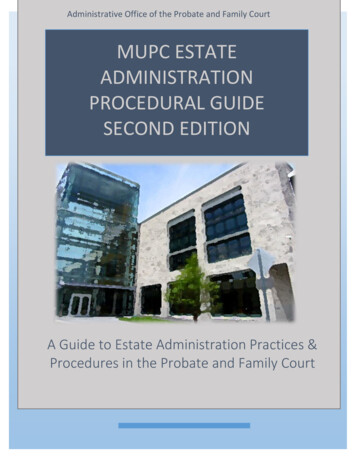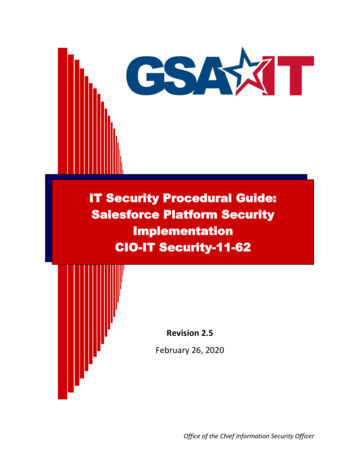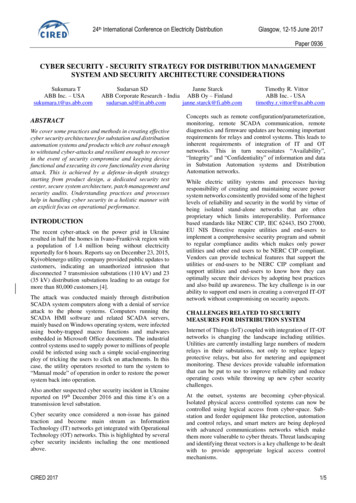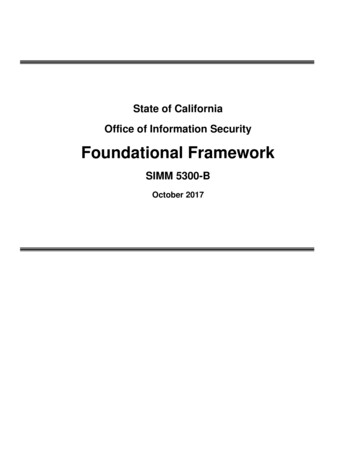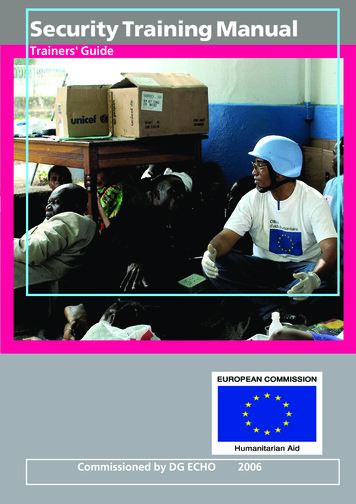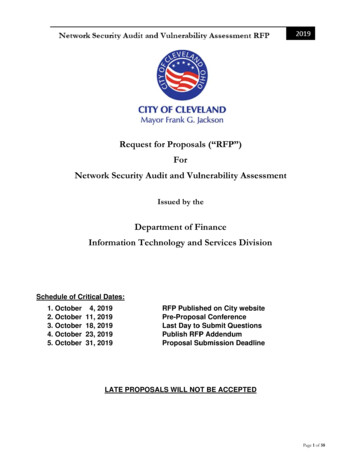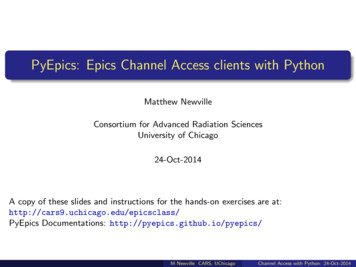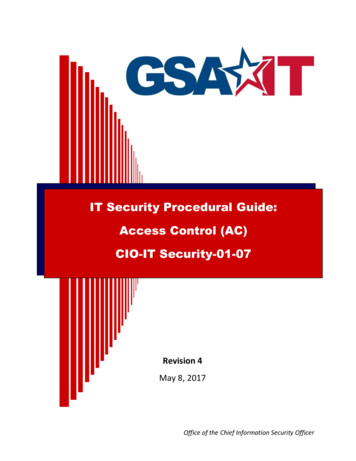
Transcription
IT Security Procedural Guide:Access Control (AC)CIO-IT Security-01-07Revision 4May 8, 2017Office of the Chief Information Security Officer
CIO-IT Security-01-07, Revision 4Access ControlVERSION HISTORY/CHANGE RECORDChangePerson PostingChangeNumberChangeRevision 2 – January 30, 20081Scott / HeardChanges made throughoutthe document to reflectFISMA, NIST and GSA CIO P2100.1B requirements.2Scott / HeardChanges throughout thedocument to correspond withrevisions made to CIO-ITSecurity-01-09, CIO-ITSecurity-06-30 and CIO-ITSecurity-01-04.3Hummel /Changes throughout theWindelbergdocument to correspond withupdate of the current versionof GSA CIO P 2100Revision 3 – April 1, 20151SitcharingChanges throughout tocorrespond with revisionsmade to CIO-IT-Security-0630.2HeardChanges the document toImplement ADM O 5440.6673Heard / MottPrivacy access informationincludedRevision 4 – May 8, 20171Feliksa/Dean/KlemensUpdate to current format,style, and polices.U.S. General Services AdministrationReason for ChangePage Number ofChangeUpdated to reflect andimplement various FISMA, NISTand GSA CIO P 2100.1Brequirements.Updated to reflect thecorrelation of the CIO-IT SecurityGuides; and to further expresspolicy within them as standalonedocumentsVariousThe most current version of GSACIO P 2100 and more detailedguidance on implementing policyVariousUpdated to reflect correlation ofthe CIO-IT Security Guide andCIO P 2100.1.ThroughoutUpdated to reflect CISO GSA ITresponsibilitiesAppendix J controls included intable 1 as well as explainedwithin the guideThroughoutUpdated to latest guidestructure. Revised to reflectupdates to Federal policies, NISTdocuments, and GSA processes.ThroughoutVariousThroughout
CIO-IT Security-01-07, Revision 4Access ControlAPPROVALIT Security Procedural Guide: Access Control, CIO-IT Security-01-07, Revision 4 is herebyapproved for distribution.5/8/2017XKurt GarbarsKurt GarbarsGSA Chief Information Security OfficerSigned by: KURT GARBARSContact: GSA Office of the Chief Information Security Officer (OCISO), Policy and ComplianceDivision, at ispcompliance@gsa.gov.U.S. General Services Administration
CIO-IT Security-01-07, Revision 4Access ControlTable of Contents1Introduction .11.11.21.31.42Purpose . 1Scope . 1Policy. 2References . 2Roles and Responsibilities .32.1 The Chief Information Security Officer (CISO) . 32.2 Authorizing Official (AO) . 32.3 Information Systems Security Manager (ISSM) . 42.4 Information System Security Officer (ISSO) . 42.5 System Owner. 42.6 Data Owners . 52.7 Contracting Officers (COs)/Contracting Officer Representatives (CORs) . 52.8 Custodians . 62.9 Authorized Users of IT Resources . 62.10 GSA Personnel Security Officer/Office of Mission Assurance . 62.11 System/Network Administrators . 62.12 Supervisors . 73ACCESS CONTROL OVERVIEW .73.1 What are Access Controls? . 73.2 Why Are Access Controls Important? . 84Access Controls Best Practices.94.1 Best Practices for Authorization . 94.1.1 Personnel Authorization Best Practices . 94.1.2 System Interconnection Authorization Best Practices . 134.1.3 Device Authorization Best Practices . 134.1.4 Media Protection Best Practices . 134.2 Best Practices for Technical Access Controls . 135GSA Implementation Guidance for AC Controls . 155.1 AC-1 Access Control Policy and Procedures . 155.2 AC-2 Account Management. 165.3 AC-3 Access Enforcement . 185.4 AC-4 Information Flow Enforcement . 185.5 AC-5 Separation of Duties. 185.6 AC-6 Least Privilege . 195.7 AC-7 Unsuccessful Logon Attempts . 205.8 AC-8 System Use Notification . 205.9 AC-10 Concurrent Session Control . 215.10 AC-11 Session Lock . 215.11 AC-12 Session Termination . 215.12 AC-14 Permitted Actions without Identification or Authentication . 225.13 AC-17 Remote Access . 22U.S. General Services Administrationi
CIO-IT Security-01-07, Revision 4Access Control5.14 AC-18 Wireless Access . 235.15 AC-19 Access Control for Mobile Devices. 235.16 AC-20 Use of External Information Systems. 245.17 AC-21 Information Sharing . 255.18 AC-22 Publicly Accessible Content . 256Summary . 26Appendix A: Definitions . 27Appendix B: GSA CIO Order 2100.1 Policy Statements on Access Control . 29U.S. General Services Administrationii
CIO-IT Security-01-07, Revision 41Access ControlIntroductionImplementing an effective access control program and adhering to GSA CIO Order 2100.1, “GSAInformation Technology (IT) Security Policy” and federal mandates are the best ways to ensurethe protection of GSA systems and resources from loss, misuse, disclosure, or impairment. Aneffective program would carefully apply necessary controls to ensure that users are givenaccess only to data and resources as needed and allowed by policy and authorization. Effectiveaccess control is implemented by a combination of personnel, physical, and logical practices,procedures, features, and mechanisms. This guide focuses on logical access controls as definedin National Institute of Standards and Technology (NIST) Special Publication (SP) 800-53,Revision 4, “Security and Privacy Controls for Federal Information Systems and Organizations” inthe Access Control (AC) family of security controls. Physical access controls are covered in GSAIT Security Procedural Guide CIO-IT Security-12-64, “Physical and Environmental Protection”.Personnel access controls are covered GSA’s Information Security Program Plan, and GSA’spersonnel security policies.Every GSA IT system must follow the access control practices identified in this guide. Anydeviations from the security requirements established in GSA CIO Order 2100.1 must becoordinated by the Information Systems Security Officer (ISSO) through the appropriateInformation Systems Security Manager (ISSM) and authorized by the Authorizing Official (AO).Any deviations, exceptions, waivers, or other conditions not following GSA policies andstandards also must be forwarded to Office of the Chief Information Security Officer (OCISO)Policy and Compliance Division (ISP) at ispcompliance@gsa.gov to establish a record of theevidence regarding the item and any resultant Plan of Action and Milestones (POA&M).The mechanisms associated with access control, when effectively applied, ensure thatindividuals or devices accessing or connecting to GSA’s IT resources are given access only todata and resources they authorized access based on their need-to-know and privileges neededto perform their job.1.1PurposeThe purpose of the guide is to provide guidance to implement GSA’s AC requirements as theyapply to the NIST SP 800-53 AC control family and GSA CIO Order 2100.1. This guide providesGSA Federal employees and contractors with significant security responsibilities guidance andinformation for implementing access control features and functions for systems under theirpurview.1.2ScopeThe procedures in this guide cover all GSA information and information systems to includethose used, managed, or operated by a GSA employees or contractors on behalf of GSA. Theseprocedures apply to all GSA employees and contractors.U.S. General Services Administration1
CIO-IT Security-01-07, Revision 41.3Access ControlPolicyThe current version of GSA CIO Order 2100.1 has numerous policy statements pertaining toaccess controls. Some of the more important responsibilities and policies are summarized here;the parenthetical information indicates the chapter and paragraph of the pertinent policystatement. For a listing of access control responsibilities see Section 2, for policy details fromthe current version of GSA CIO Order 2100.1, see Appendix B. 1.4System owners must grant system access based on a valid need-to-know/need-toshare. (Chapter 2, 13.dd)System and data owners must ensure system access is restricted to authorizedusers. (Chapter 2, 13.ee, 14.c)System and data owners must ensure access authorization is appropriate at leastannually. (Chapter 2, 13.m, 14.d)Information systems must operate in such a way that they run with the least amountof system privilege needed to perform a specific function and that system access isgranted on a need to know basis. (Chapter 4, 2.u)All GSA systems must implement logical access controls to authorize or restrict theactivities of users and system personnel to authorized transactions and functions.(Chapter 5, 2.b)Supervisors of GSA employees and CORs of GSA contractors must be responsible forcoordinating and arranging system access requests for all new or transferringemployees and for verifying an individual’s need-to-know (authorization). (Chapter4, 2.a(3))User authorizations must be verified annually for all information systems. (Chapter4, 2.a(5))Users must utilize access rights based on a need to know. (Chapter 2, 17.i)Written management authorization for system interconnection, based upon theacceptance of risk to the IT system, must be obtained from the Authorizing Officialsof both systems prior to connecting a system not under a single Authorizing Official’scontrol in accordance with NIST SP 800-47, “Security Guide for InterconnectingInformation Technology Systems”. Per NIST 800-47, an interconnection is the directconnection of two or more IT systems for the purpose of sharing data and otherinformation resources through a pipe, such as ISDN, T1, T3, DS3, VPN, etc. (Chapter3, 2.i(1))References FIPS 199, “Standards for Security Categorization of Federal Information and InformationSystems”GSA CIO Order 2100.1, “GSA Information Technology (IT) Security Policy”GSA CIO Order 2104.1, “GSA Information Technology (IT) General Rules of Behavior”CIO-IT Security-12-64, “Physical and Environmental Protection”GSA Information Security Program PlanU.S. General Services Administration2
CIO-IT Security-01-07, Revision 4 2Access ControlNIST SP 800-47, “Security Guide for Interconnecting Information Technology Systems”NIST SP 800-53 Revision 4, “Security and Privacy Controls for Federal InformationSystems and Organizations”Roles and ResponsibilitiesThere are many roles associated with implementing an effective access control program.System owners for each information system are responsible for ensuring that access controlprocesses exist for their specific system and that the appropriate people have been assignedaccess control related roles and responsibilities.The System Program Managers/Project Managers have direct responsibility to ensure effectiveimplementation and management of GSA’s access controls requirements for each of theirsystems. The roles and responsibilities provided in this section have been extracted orparaphrased from GSA CIO Order 2100.1 or summarized from GSA and Federal guidance.Throughout this guide requirements for implementing access control are described. Completeroles and responsibilities for agency management officials and roles with significant IT Securityresponsibilities are defined in GSA CIO Order 2100.1.2.1The Chief Information Security Officer (CISO)Responsibilities include the following: 2.2Reporting to the GSA CIO on the implementation and maintenance of the GSA's ITSecurity Program and Security Policies;Implementing and overseeing GSA's IT Security Program by developing and publishing ITSecurity Procedural Guides that are consistent with this policy;Directing the planning and implementation of the GSA IT Security Awareness andPrivacy Training Program to ensure agency personnel, including contractors, receiveappropriate security and privacy awareness training based on their roles and access toinformation and information systems;Periodically assessing risk and magnitude of the harm resulting from unauthorizedaccess, use, disclosure, disruption, modification, or destruction of information andinformation systems that support the operations and assets of the agency.Authorizing Official (AO)Responsibilities include the following: Implementing detailed separation of duties policies for IT systems based on the specificprocesses, roles, permissions, and responsibilities of personnel involved in GSA businessoperations; Establishing physical and logical access controls to enforce separation of duties policyand alignment with organizational and individual job responsibilities; Ensuring that GSA information systems under their purview have implemented therequired AC controls in accordance with GSA and Federal policies and requirements;U.S. General Services Administration3
CIO-IT Security-01-07, Revision 4 2.3Access ControlEnsuring a plan of action and milestones (POA&M) item is established and managed toaddress AC Controls that are not fully implemented.Information Systems Security Manager (ISSM)Responsibilities include the following: 2.4Ensuring adherence and proper implementation of GSA’s IT Security Policy;Ensuring assessment and authorization support documentation is developed andmaintained (including the implementation of access controls);Managing POA&Ms regarding AC controls for all systems under their purview;Ensuring ISSOs and System Owners are maintaining POA&Ms regarding AC controls fortheir systems, including taking remediation actions according to scheduled milestones.Information System Security Officer (ISSO)Responsibilities include the following: 2.5Ensuring the system is operated, used, maintained, and disposed of in accordance withinternal security policies and procedures. Necessary security controls (including accesscontrols) should be in place and operating as intended;Assisting the Authorizing Official, Data Owner and Contracting Officer / ContractingOfficer Representative in ensuring users have the required background investigations,the required authorization and need-to-know, and are familiar with internal securitypractices before access is granted to the system;Reviewing system role assignments to validate compliance with principles of leastprivilege;Assisting in the identification, implementation, and assessment of a system’s securitycontrols, including common controls.Developing POA&Ms regarding AC controls for all systems under their purviewSystem OwnerResponsibilities include the following: Ensuring their systems and the data each system processes have necessary securitycontrols in place (including access controls) and are operating as intended and protectedin accordance with GSA regulations and any additional guidelines established by theISSO or ISSM;Conducting annual reviews and validations of system users’ accounts to ensure thecontinued need for access to a system and verify users’ authorizations(rights/privileges);Defining, implementing, and enforcing detailed separation of duties by ensuring thatsingle individuals do not have control of the entirety of a critical process, roles,permissions, and/or responsibilities;U.S. General Services Administration4
CIO-IT Security-01-07, Revision 4 2.6Access ControlCoordinating with IT security personnel including the ISSM and ISSO and Data Owners toensure implementation of system and data security requirements;Working with the ISSO and ISSM to develop, implement, and manage POA&Ms(including the AC control family) for their respective systems IAW IT Security ProceduralGuide: Plan of Action and Milestones (POA&M), CIO-IT Security-09-44;Ensuring proper separation of duties for GSA IT system maintenance, management, anddevelopment processes;Working with the Data Owner, granting access to the information system based on avalid need-to-know/need-to-share that is determined during the account authorizationprocess and the intended system usage;Working with Data Owners with assistance from the ISSO, will ensure system access isrestricted to authorized users that have completed required background investigations,are familiar with internal security practices, and have completed requisite security andprivacy awareness training programs, such as the annual IT Security & Privacy Acttraining curriculum.Data OwnersResponsibilities include the following: 2.7Working with the system owner, with assistance from the ISSO, to ensure system accessis restricted to authorized users that have completed required backgroundinvestigations, are familiar with internal security practices, and have completedrequisite security and privacy awareness training programs;Ensuring system access authorizations enforce job function alignment, separation ofduties, and are based on the principle of need-to-know/need-to-share that isdetermined during the account authorization process and the intended system usage.Reviewing access authorization listings and determining whether they remainappropriate at least annually;Coordinating with IT security personnel including the ISSM and ISSO and system ownersto ensure implementation of system and data security requirements.Contracting Officers (COs)/Contracting Officer Representatives (CORs)Responsibilities include the following: Working with the CISO to facilitate the monitoring of contract performance forcompliance with the agency’s information security policy;Identifying and initiating contractor background investigations in collaboration with theGSA Personnel Security Officer;Ensuring that all IT acquisitions include the appropriate security requirements in eachcontract and task order;Ensuring that the appropriate security and privacy contracting language is incorporatedin each contract and task order;U.S. General Services Administration5
CIO-IT Security-01-07, Revision 4 2.8Access ControlEnsuring new solicitations include the language as required by GSA IT SecurityProcedural Guide CIO-IT Security 09-48, “Security Language for IT Acquisition Efforts”.CustodiansResponsibilities include the following: 2.9Coordinating with data owners and system owners to ensure the data is properly stored,maintained, and protected.Accessing data only on a need to know basis as determined by the Data Owner.Authorized Users of IT ResourcesResponsibilities include the following: Complying with all GSA security policies and procedures.Complying with security training, education, and awareness sessions commensuratewith their duties.Familiarizing themselves with any special requirements for accessing, protecting, andusing data, including Privacy Act requirements, copyright requirements, andprocurement-sensitive data;Ensuring that adequate protection is maintained on their workstation, including notsharing passwords with any other person and logging out, locking, or enabling apassword protected screen saver before leaving their workstation;Utilizing assigned privileged access rights (power user, database administrator, web siteadministrator, etc.) to a computer based on need to know.2.10 GSA Personnel Security Officer/Office of Mission AssuranceResponsibilities include the following: Developing and implementing access agreements, and personnel screening, termination,and transfer procedures; Ensuring consistent and appropriate sanctions for personnel violating management,operation, or technical information security controls.2.11 System/Network AdministratorsResponsibilities include the following: Ensuring the appropriate security requirements (including access controls) areimplemented consistent with GSA IT security policies and hardening guidelines.Utilizing privileged access rights (e.g., “administrator”, “root”, etc.) to a computer basedon a need to know;Ensuring system/network administrators have separate Administrator and Useraccounts, if applicable (e.g., Microsoft Windows accounts). The Administrator privilegedU.S. General Services Administration6
CIO-IT Security-01-07, Revision 4 Access Controlaccount must only be used when Administrator rights are required to perform a jobfunction. A normal user account should be used at all other times.Creating, modifying, and deleting accounts, access rights/privileges, and roles incooperation with the system owner, data owner, and ISSM/ISSO.2.12 SupervisorsResponsibilities of the Supervisors include the following: 33.1Conducting annual review and validation of staff user accounts to ensure the continuedneed for access to a system;Coordinating and arranging system access requests for all new or transferringemployees and for verifying an individual’s need-to-know (authorization);Coordinating and arranging system access termination for all departing or resigningpersonnel;Coordinating and arranging system access modifications for personnel;Documenting job descriptions and roles to accurately reflect the assigned duties,responsibilities, and separation of duties principles. Establishing formal procedures toguide personnel in performing their duties, with identification of prohibited actions.ACCESS CONTROL OVERVIEWWhat are Access Controls?Access control, as it relates to this guide, pertains to granting or denying logical access to aresource, such as data/information or a system. Access is typically gained by an individual (auser of the resource), for example a GSA employee or a contractor; sometimes individuals areaggregated into groups. It is also possible to have automated system-to-system access, knownas system interconnection.Identification, authentication, and authorization are key terms regarding access control. Eachuser of a resource should have a unique identifier. In some situations access for anonymoususers may be considered as an option. However, this type of access must be based on a soundrisk management decision, with documented controls and approved by the Authorizing Officialof the resource. Authentication involves attempting to verify the user’s identity through one ormore credentials; e.g., an ID card, a password, a signature, or a biometric such as a fingerprint.Authorization determines what the individual is allowed and is not allowed to do with theresource, such as view the resource but not delete it.An access control list (ACL) specifies what access rights are permitted to a user. Groups of usersmay also be classified by assigned and documented roles and the access rights may be assignedU.S. General Services Administration7
CIO-IT Security-01-07, Revision 4Access Controlto the roles; in role-based access controls, users obtain only the rights assigned to the group(role) as a whole.3.2Why Are Access Controls Important?Employing effective access controls based on sound risk management decisions protects GSAresources from internal and external threats and provides a level of assurance that the agencycan successfully perform its mission.Effective access controls also improve the overall security posture of the agency by: Ensuring the confidentiality, integrity, and availability of IT resources and data;Enhancing the ability to determine where a breach has occurred;Creating greater individual accountability for personnel;Limiting user access only to needed information required to perform specificresponsibilities (i.e., need to know, least privilege access); Limiting access to sensitive resources (e.g., financial records, security softwareprograms, or data centers). Ensuring the agency complies with Federal regulations and mandates to reduce oreliminate federal reprimands.Without effective access controls, GSA increases the possibility of information loss or theft,regardless of its sensitivity, and limits the control of who has access to that information.Confidentiality, integrity, and availability of information are also an issue when access controlsare not properly implemented. If a security breach affects one area of the network, and thereare insufficient access controls present to contain or mitigate the breach, its reach may beexpanded, affecting additional systems, components, and data. Improperly implemented accesscontrols can result in negative consequences, ranging from a lack of information being availableto compromised data integrity and/or lack of confidentiality. There is also a possibility of anegative financial impact due to the response to or recovery from a breach. Furthermore, legalissues may also occur for not complying with laws and regulations, resulting in regulatoryadmonishment, fines and more.Ineffective access controls also hinder accountability for the action of users of an IT resource,whether it is a system or its data.The following section explains best practices for access controls, addressing: Authorizations, whether for personnel, system interconnections, or devicesTechnical access controls for information systems.U.S. General Services Administration8
CIO-IT Security-01-07, Revision 44Access ControlAccess Controls Best PracticesAccess controls are categorized as preventive controls. Preventive controls are proactive andused to deter unauthorized access to IT resources. Controlling logon/logoff to an informationsystem and verifying whether an individual is authorized specific types of access to the systemand its data a preventive control. Detective controls, on the other hand, are reactive and warnpersonnel of violations or attempted violations when or after they have occurred. Reviewingaccess logs falls into the category of a detective control, these controls are covered in otherGSA IT Security Procedural guides.4.1Best Practices for AuthorizationIdentification, authentication, and authorization must apply to t
the Access Control (AC) family of security controls. Physical access controls are covered in GSA IT Security Procedural Guide CIO-IT Security-12-64, "Physical and Environmental Protection". Personnel access controls are covered GSA's Information Security Program Plan, and GSA's personnel security policies.
